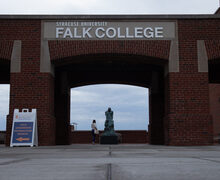City, county battle over proposed site
The Midland plant is part of a $380 million plan to clean up Onondaga Lake, the most polluted lake in the country. The plan came as part of a consent settlement in a 1988 lawsuit between the county and Atlantic States Legal Foundation, New York State and the State Department of Environmental Conservation. The foundation sought to force the county to comply with the Federal Clean Water Act, arguing that the county sewage system caused excess pollution in Onondaga Lake when the system overflowed during times of high usage, including heavy rainfall and melting snow.
In addition to the three regional treatment facilities, the plan includes improvements and upgrades to the county’s main sewage treatment plant and the establishment of a program to track the effect of the cleanup projects on water quality in the lake.
All of the involved parties in the lawsuit approved the final plan, Cunningham said.
The bulk of the lake’s pollution came as a byproduct of expanding industries in the early 1900s. By 1940, the lake was declared unsafe for swimming, and fishing was banned by the 1970s. In 1994, the lake’s bottom was designated as a environmentally contaminated area by the federal government because of mercury contamination.
Some critics argue the county cleanup plan will do little to solve the lake’s pollution problems.
‘It’s just a Band-Aid,’ said Myrnah Hall, a professor of environmental sciences at the State University of New York College of Environmental Science and Forestry.
A political quagmire
These arguments against the project pressed the city to take a pro-active role against the construction, a move that some country representatives say was an effort to avoid dealing with the situation.
‘The city is not so much opposed to it as they don’t want to deal with it,’ Prickard said.
But O’Connell quickly countered that criticism.
‘That’s absurd,’ she said. ‘We clearly, with intent, choose to go forward and tried to get them to not build this plant.’
The controversy between the city and the county has not only slowed down the construction process, but severed an important link between the municipalities, Cunningham said.
‘The city has a level of responsibility in helping the county overcome this,’ he said. ‘But the city has turned around and said ‘No, don’t bother us.’ It’s affected the project dramatically.’
Nonetheless, the county moves forward as if it already owns the land, Cunningham added.
Peter Thompson, who works with Atlantic States, said while the county should have worked with the community earlier in the planning process, its intent behind the Midland plant would meet its obligation to fulfill federal standards.
‘One thing that has been forgotten since the neighborhood people have gotten politically involved is that the county does not have to appease the city,’ Thompson said. ‘Midland is just a tiny piece of this whole sewage treatment issue. There’s a great big picture here.’
Caught in the crossfire
The county argues that its decisions on the Midland project will affect the plans for the other two plant sites, one on Clinton Street near Armory Square and one on Harbor Brook near Onondaga Lake.
‘Downstream, the same set of problems exists for the city,’ Prickard said. ‘I assume those communities are going to react the same way.’
Because of limited space and finances, the county will not be able to build an underground storage facility at more than one site.
Some business owners in Armory have already confronted the county with complaints about the plant in their district, Cunningham said. Thompson, however, said because of the delays with the Midland process, some Armory business owners may think the project will never actually happen.
But even some opposed to the plan anticipate a county victory in the end.
‘I think all we know where it’s going,’ O’Connell said. ‘It’s very unfortunate.’
Published on April 28, 2003 at 12:00 pm




